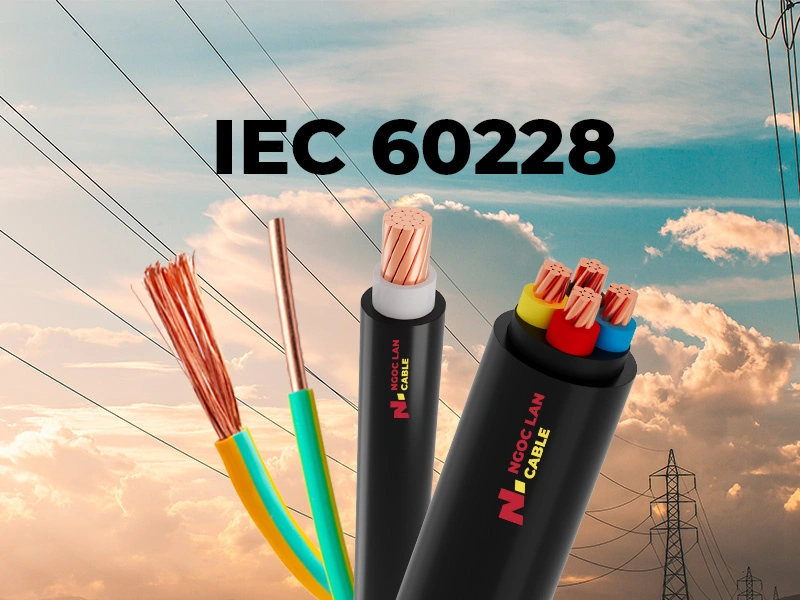IEC 60228 is an international standard issued by the International Electrotechnical Commission (IEC), specifying technical requirements and characteristics for low voltage electrical conductors. This is an important standard in the electrical industry, aimed at ensuring safety, quality, and electrical transmission performance of conductors.
This article provides a comprehensive overview of the IEC 60228 standard, including:
- Detailed classification of 4 conductor classes (class 1, 2, 5, 6) with construction characteristics and specific applications
- Complete technical reference tables for resistance, number of wires, and diameter according to nominal cross-sectional area
- Updates on the IEC 60228:2023 version with important changes expanding the scope
- Answers to frequently asked questions about the differences between classes and selection method.
- Official reference sources to verify information from the IEC Webstore.
If you are looking for technical reference documentation on cable conductor standards, this article can support your design work and quality evaluation. Ngoc Lan Cable applies the standard in the production process to ensure product quality.

1. Overview of IEC 60228 standard
IEC 60228 is a technical standard that specifies the nominal cross-sectional area of conductors in power cables and electric building wires ranging from 0.5 mm² to 2,500 mm². This standard is issued by the International Electrotechnical Commission (IEC) to establish unified global technical requirements. The current version is IEC 60228:2004 (edition 3.0), which was updated to edition 4.0 in 2023.
In Vietnam, TCVN 6612:2007 is issued by the Ministry of Science and Technology. This standard is completely equivalent to IEC 60228:2004. Currently, electric wire products manufactured at Ngoc Lan Cable reference TCVN 6612:2007 in the production process to ensure compliance with national standards.
| Information | Details |
|---|---|
| Document number | IEC 60228:2023 |
| Issuing organization | International Electrotechnical Commission |
| Standard scope | Applicable to copper, aluminum and aluminum alloy conductors, nominal cross-sectional area from 0.5 mm² to 2500 mm² |
| Status | Currently in effect |
| Previous version | IEC 60228:2004 |
2. Classification of 4 conductor classes according to IEC 60228
IEC 60228 classifies conductors into 4 classes based on construction and flexibility. Each class is suitable for specific application groups. Understanding the differences between conductor types helps you select the appropriate cable type. Additionally, this understanding helps avoid technical risks during use.
2.1. Class 1 – Solid conductor
Fixed installation applications require conductors with high rigidity. Class 1 solid conductors consist of a single metal wire that meets this requirement. Class 1 conductors have lower resistance than all other conductor classes. In addition, the production cost of Class 1 conductors is also significantly lower.
2.2. Class 2 – Stranded conductor
Fixed installations often face difficulties when bending is required during construction. Class 2 conductors are created by stranding multiple metal wires together. Thanks to the stranded structure, Class 2 conductors have higher flexibility than Class 1. Therefore, this type is suitable for fixed installations with bending requirements.
2.3. Class 5 – Flexible conductor
Portable equipment requires cables with high bending durability due to frequent movement. Class 5 flexible conductors are made up of many small-diameter wires. You can choose Class 5 for portable electric wires and equipment connection cables.
2.4. Class 6 – Extra flexible conductor
Handheld equipment and industrial robots require high flexibility. Class 6 extra flexible conductors have a large number of wires with thin wire diameters. Class 6 meets stringent requirements for bending durability in mobile environments.
| Characteristic | Class 1 | Class 2 | Class 5 | Class 6 |
|---|---|---|---|---|
| Construction | 1 solid wire | Multiple stranded wires | Multiple thin wires | Very many wires, wire diameter smaller than Class 5 conductor |
| Flexibility | Rigid | Medium | Flexible | Extra flexible |
| Resistance (same cross-section) | Lower than all | Low | Medium | Medium – High |
| Main application | Fixed installation | Fixed installation, construction | Portable equipment | Handheld equipment, robots |
| Applicable materials | Copper, aluminum | Copper, aluminum | Copper only | Copper only |
After understanding the classification of 4 classes, referencing detailed technical parameters helps you design systems more accurately. The next section provides complete reference tables.
3. Detailed technical reference tables according to IEC 60228
IEC 60228 reference tables provide important technical parameters. The two tables below summarize the parameters for the 4 classes of copper conductors.
| Nominal cross-sectional area(mm²) | Class 1 – Number of wires | Class 2 – Minimum number of wires | Maximum DC resistance of conductor at 20°C (Ω/km) | |
|---|---|---|---|---|
| Round | Circular compacted | |||
| 0.5 | 1 | 7 | – | 36.0 |
| 0.75 | 1 | 7 | – | 24.5 |
| 0.5 | 1 | 7 | – | 18.1 |
| 1.5 | 1 | 7 | 6 | 12.1 |
| 2.5 | 1 | 7 | 6 | 7.41 |
| 4 | 1 | 7 | 6 | 4.61 |
| 6 | 1 | 7 | 6 | 3.08 |
| 10 | 1 | 7 | 6 | 1.83 |
| 16 | 1 | 7 | 6 | 1.15 |
| 25 | 1 | 7 | 6 | 0.727 |
| 35 | 1 | 7 | 6 | 0.524 |
| 50 | 1 | 19 | 6 | 0.387 |
| 70 | 1 | 19 | 12 | 0.268 |
| 95 | 1 | 19 | 15 | 0.193 |
| 120 | 1 | 37 | 18 | 0.153 |
| 150 | 1 | 37 | 18 | 0.124 |
| 185 | 1 | 37 | 30 | 0.0991 |
| 240 | 1 | 37 | 34 | 0.0754 |
Table 2: Technical specifications for class 5 & class 6 (copper conductors)
| Nominal cross-sectional area (mm²) | Class 5 – Maximum diameter of wires in conductor (mm) | Class 6 – Maximum diameter of wires in conductor (mm) | Maximum DC resistance of conductor at 20°C (Ω/km) |
|---|---|---|---|
| 0.5 | 0.21 | 0.16 | 39.0 |
| 0.75 | 0.21 | 0.16 | 26.0 |
| 1.0 | 0.21 | 0.16 | 19.5 |
| 1.5 | 0.26 | 0.16 | 13.3 |
| 2.5 | 0.26 | 0.16 | 7.98 |
| 4 | 0.31 | 0.16 | 4.95 |
| 6 | 0.31 | 0.21 | 3.30 |
| 10 | 0.41 | 0.21 | 1.91 |
| 16 | 0.41 | 0.21 | 1.21 |
| 25 | 0.41 | 0.21 | 0.780 |
| 35 | 0.41 | 0.21 | 0.554 |
| 50 | 0.41 | 0.31 | 0.386 |
| 70 | 0.51 | 0.31 | 0.272 |
| 95 | 0.51 | 0.31 | 0.206 |
| 120 | 0.51 | 0.31 | 0.161 |
| 150 | 0.51 | 0.31 | 0.129 |
| 185 | 0.51 | 0.41 | 0.106 |
| 240 | 0.51 | 0.41 | 0.0801 |
Note: Class 5 and 6 have higher resistance than class 1 & 2 with the same cross-sectional area. Wire diameter decreases progressively from class 5 to class 6 to increase flexibility.
The tables above are based on IEC 60228:2004 version. The new version released in 2023 has important updates that expand application capabilities.
4. What's new in the IEC 60228:2023 version?
The demand for high-power electrical transmission in large-scale projects is increasing. Therefore, IEC 60228:2023 has expanded the scope of application for cross-sectional areas up to 3500 mm² to meet this demand. The version also introduces Milliken conductor technology.
The maximum cross-sectional area has increased from 2500 mm² to 3500 mm². Thanks to this update, large power plants and extra-high voltage transmission lines have additional standardization options, helping to optimize costs for large-scale projects.
Milliken conductors are a new technology added to the standard. The optimized stranded structure of Milliken helps reduce skin effect. Thanks to the optimized stranding characteristics, Milliken technology improves transmission performance at high frequencies.
TCVN 6612:2007 in Vietnam remains equivalent to IEC 60228:2004. Projects requiring the new standard can directly reference IEC 60228:2023. The corresponding TCVN update may be implemented in the future.
5. FAQ – Frequently asked questions about IEC 60228
5.1. What is the difference between class 2 and class 5 conductors?
Class 5 conductors have more thin wires and are more flexible than Class 2. The resistance of Class 5 is approximately 4-5% higher than Class 2 with the same cross-sectional area.
For example, a 10 mm² Class 2 copper conductor has a maximum resistance of 1.83 Ω/km, while Class 5 with the same cross-sectional area has a resistance of 1.91 Ω/km.
5.2. Can I use aluminum conductors for flexible cables?
Flexible cables require good mechanical properties due to frequent bending, while aluminum conductors have inferior mechanical properties compared to copper, making them unsuitable. IEC 60228 only permits the use of aluminum for class 1 and class 2 conductors.
5.3. Is TCVN 6612:2007 still relevant now that IEC 60228:2023 has been released?
Most projects in Vietnam use cross-sectional areas from 0.5 mm² to 2500 mm². TCVN 6612:2007 remains in effect and is suitable for this range, meeting requirements for the majority of industrial system and construction applications.
Special projects requiring cross-sectional areas above 2500 mm² can reference IEC 60228:2023 directly.
5.4. Where can I purchase or reference the IEC 60228 standard?
The IEC 60228 standard is a copyrighted document of the IEC. You can access the IEC Webstore – IEC 60228 to view details and purchase the official version. The website provides both PDF and printed versions at a price of approximately CHF 115 (price updated October 13, 2025).
Additionally, you can reference TCVN 6612:2007 free of charge at Vietnamese standards libraries.
6. Application of IEC 60228 in cable selection
Selecting inappropriate electrical cables causes cost waste or safety risks. Understanding IEC 60228 helps you select suitable cables for each project.
Benefits when referencing IEC 60228:
- Select cables with appropriate conductors based on application flexibility requirements
- Evaluate installation environment to choose corresponding conductor types
- Assess construction to ensure correct number of wires and standard diameter
- Support safe operation when complying with resistance limit values
- Reference in bidding processes when products meet international standards
In practice, applying the IEC 60228 standard requires in-depth understanding of technical characteristics. Ngoc Lan Cable manufactures a complete range of electrical cables according to the standard. You can learn more about technical specifications on the ecatalogue or contact us for consultation on suitable cable solutions.

 VN
VN